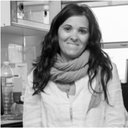Validation of determination of plasma metabolites derived from thyme bioactive compounds by improved liquid chromatography coupled to tandem mass spectrometry.
Keywords
Abstract
In the present study, a selective and sensitive method, based on microelution solid-phase extraction (μSPE) plate and ultra-performance liquid chromatography coupled to tandem mass spectrometry (UPLC-MS/MS) was validated and applied to determine the plasma metabolites of the bioactive compounds of thyme. For validation process, standards of the more representative components of the phenolic and monoterpene fractions of thyme were spiked in plasma samples and then the quality parameters of the method were studied. Extraction recoveries (%R) of the studied compounds were higher than 75%, and the matrix effect (%ME) was lower than 18%. The LODs ranged from 1 to 65 μg/L, except for the thymol sulfate metabolite, which was 240 μg/L. This method was then applied for the analysis of rat plasma obtained at different times, from 0 to 6h, after an acute intake of thyme extract (5 g/kg body weight). Different thyme metabolites were identified and were mainly derived from rosmarinic acid (coumaric acid sulfate, caffeic acid sulfate, ferulic acid sulfate, hydroxyphenylpropionic acid sulfate, dihydroxyphenylpropionic acid sulfate and hydroxybenzoic acid) and thymol (thymol sulfate and thymol glucuronide). The most abundant thyme metabolites generated were hydroxyphenylpropionic acid sulfate and thymol sulfate, their respective concentrations in plasma being 446 and 8464 μM 1h after the intake of the thyme extract.



